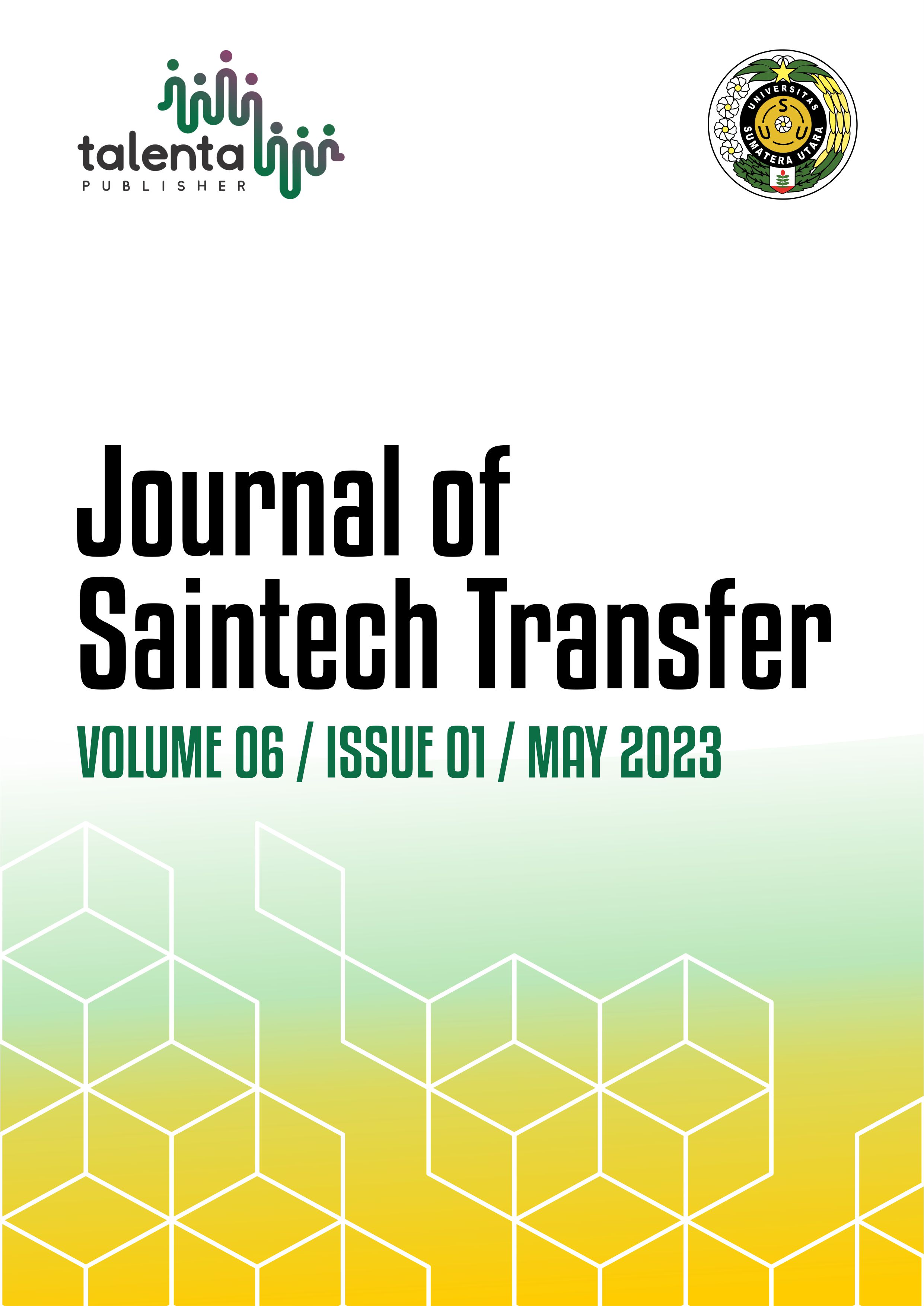- Increasing the Independence of Oyster Mushroom (Pleurotus ostreatus) Entrepreneurs in Seedlings Preparation
-
DOI:
https://doi.org/10.32734/jst.v6i1.9845Keywords:
Independence, Oyster mushroom, SeedlingAbstract
Sadam Mushroom House is one of the mushroom producers in Medan Marelan with oyster mushroom production of 7-12 kg/day and can accommodate 7,000 baglogs. The problem of the oyster mushroom business is still very dependent on mushroom nurseries in an effort to provide F2 seedlings because there are still very limited facilities, infrastructure, understanding and skills in providing F0 - F2 seeds. Another problem is that the baglogs waste produced (2,000-3,000 baglogs every 3 months) has not been used properly so that it has the potential to pollute the environment. The purpose of this community service is to increase the independence of partners in providing oyster mushroom seeds, making compost from baglog waste and its use in plant cultivation. The solutions offered in solving these problems are the introduction of appropriate technology in the supply of F0-F2 mushroom seeds, the introduction of technology transfer goods, the management of baglog waste into compost and the use of compost from baglog waste as organic fertilizer for plant cultivation. The results of the community service that have been achieved are the introduction of technology transfer goods in the form of an autoclave, simple laminar air flow and tools for providing F0-F2 seedlings, training and assistance in providing F0-F2 mushroom seedling, training and assistance in making compost from baglog mushroom waste, direct practice of using mushroom compost for cultivating mung bean crop.
Downloads
References
J. Nasution, “Kandungan karbohidrat dan protein jamur tiram putih (Pleurotus ostreatus) pada media tanam serbuk kayu kemiri (Aleurites moluccana) dan serbuk kayu campuran†[Carbohydrate and protein content of white oyster mushroom (Pleurotus ostreatus) in the planting medium of candlenut sawdust (Aleurites moluccana) and mixed sawdust]. EKSAKTA: MIPA Research and Learning Journal vol. 1, no 1, pp. 38-41, 2016. (in Indonesian).
G. H.TörÅ‘s, H. El-Ramady, and Prokisch. “Edible mushroom of Pleurotus spp.: a case study of oyster mushroom (Pleurotus ostreatus L.)â€. Environment, Biodiversity and Soil Security, vol. 6, pp. 51-59, 2022. DOI: 10.21608/jenvbs.2022.117554.1161.
N. Widyastuti, “Pengolahan jamur tiram (Pleurotus ostreatus L.) sebagai alternatif pemenuhan nutrisi†[Processing of Oyster Mushroom (Pleurotus ostreatus) as an alternative to fulfillment of nutrition]. Jurnal Sains dan Teknologi Indonesia vol. 15, no. 3, pp. 1-7, 2019. (In Indonesian).
O. Agunloye, G. Oboh, and A. O. Falade, “Pleurotus ostreatus and Lentinus subnudus supplemented diets restore altered acetylcholinesterase, butyrylcholinesterase activities and improve antioxidant status in transgenic Drosophila melanogaster modelâ€. Journal of Dietary Supplements, vol 18, pp. 372–386, 2020.
M. Khoiriyah, A. Zuhriyah, and A. Basith, “Pengaruh pemberian ekstrak infusa jamur tiram (Pleurotus ostreatus) terhadap penurunan kadar gula darah pada tikus putih jantan wistar (Rattus norvegicus) [The effect of oyster mushroom (Pleurotus ostreatus) infusion extract on reducing blood sugar levels in wistar male white rats (Rattus norvegicus)â€. JAPRI: Jurnal Penjas dan Farmasi, vol. 3, no. 1, pp. 33-43, 2020.
J. Nongthombam, A. Kumar, B. G V. V. S. N. Ladli, M. Madhushekhar, and S. Patidar, “A review on study of growth and cultivation of oyster mushroomâ€. Plant Cell Biotechnology and Molecular Biology, vol. 22, no 5&6, pp. 55-65, 2021.
L. Dicks, and S. Ellinger, “Effect of the intake of oyster mushrooms (Pleurotus ostreatus) on cardiometabolic parameters—A systematic review of clinical trialsâ€. Nutrients, vol. 12, no. 4, pp. 1134, 2020.
O. M. Agunloye, and G. Oboh, “Blood glucose lowering and effect of oyster (Pleurotus ostreatus)â€and shiitake (Lentinus subnudus)â€supplemented diet on key enzymes linked diabetes and hypertension in streptozotocinâ€induced diabetic in ratsâ€. Food Frontiers, vol. 3, no. 1, pp. 61-171, 2022.
F.R. Fivintari, R. Wulandari, and O. Wijaya, “Pendampingan pengembangan usaha agribisnis jamur tiram sebagai upaya peningkatan pendapatan keluarga†[Assistance for development of oyster mushroom agribusiness as an effort to increase family income]. Community Empowerment, vol. 6, no. 4, pp. 641-648, 2021. (In Indonesian).
D. Wulanjari, S. Setiyono, and S. Prastowo, “Pemberdayaan masyarakat desa panti dan suci melalui kegiatan budidaya dan agribisnis jamur tiram dengan pola kemitraan untuk memanfaatkan waktu luang" [Empowerment of panti and suci village communities through oyster mushroom cultivation and agribusiness activities with a partnership pattern to utilize free time]. Warta Pengabdian, vol. 14, no. 1, pp. 40-48, 2020. (In Indonesian).
V. Rantiana, “peran added value pada pemanfaatan limbah daun nanas sebagai pakan hewan ternak dalam meningkatkan pendapatan masyarakat perspektif ekonomi islam (studi kasus di Desa Sugihwaras Kecamatan Ngancar Kabupaten Kediri)†[the role of added value in utilizing pineapple leaf waste as livestock feed in increasing community income from an islamic economic perspective (case study in Sugihwaras Village, Ngancar District, Kediri Regency)]. Research paper: IAIN, 2020. (In Indonesian).
D. Sulaiman, “Efek kompos limbah baglog jamur tiram putih terhadap sifat fisik tanah serta pertumbuhan bibit markisa kuning†[The effect of white oyster mushroom baglog waste compost on soil physical properties and the growth of yellow passion fruit seedlings]. Bogor: Bogor Agricultural Institute, 2011. accessed via repository. ipb.ac.id/jspui/bitstream/123456789/53343/1/A11dsu.pdf. (In Indonesian).
N. L. Rahma, A. S. Novia, and H. Nur “Karakteristik kompos berbahan dasar limbah baglog jamur tiram (kajian konsentrasi em4 dan kotoran kambing“. [Characteristics of oyster mushroom-based baglog compost (study of em4 and goat manure concentrations)]. Jurnal Industri vol. 4, no. 1, pp. 1-9, 2016. (In Indonesian).
N. L. Rahmah, A. Sakunda, H. P. Maimunah, H. Nur, and Wignyanto. “Pembuatan kompos limbah baglog jamur tiram: kajian konsentrasi kotoran kambing dan EM4 serta waktu pembalikanâ€. [Making oyster mushroom baglog waste compost: study of concentration of goat manure and EM4 and turning time]. Jurnal Teknologi Pertanian, vol. 15 no. 1, 2014. (In Indonesia).
N. L. Siregar, “Pemanfaatan limbah baglog jamur dan kompos (Mucuna bracteata) terhadap pertumbuhan dan produksi tanaman mentimun (Cucumis sativus L.)â€. [Utilization of mushroom baglog waste and compost (Mucuna bracteata) on the growth and production of cucumber plants (Cucumis sativus L.)]. Medan: University of Medan Area, 2020. accessed via repository. https://repositori.uma.ac.id/bitstream/123456789/15208/1/168210011%20-%20Naomi%20Lamtarida%20Siregar%20-%20Fulltext.pdf. (In Indonesian).
J. Atini, Z. Rahmi, and H. Tuti, “Pemanfaatan limbah media tanam jamur tiram putih (Pleurotus ostreatus L.) sebagai kompos dan pengaruhnya terhadap hasil tanaman okra (Abelmoschus esculentus L. Moench)â€. [Pleurotus ostreatus L. utilization of white oyster mushroom (Pleurotus ostreatus L.) growing media waste as compost and its effect on okra plant yield (Abelmoschus esculentus L. Moench). JTAM Agrotek View, vol. 1, no. 2, 2018. (In Indonesian).
M. Siregar, and A. H. Idris, “The production of F0 oyster mushroom seeds (Pleurotus ostreatus), the post-harvest handling, and the utilization of baglog waste into compost fertilizerâ€. Journal of Saintech Transfer, vol. 1, no 1, pp. 58-68, 2018.
Jumar, R. A. Saputra, M. I. Nugraha, and A. Ghazali, “The effect of composted oyster mushroom baglog waste on rice growth and productivity in acid sulfate soilsâ€. In AIP Conference Proceedings, vol. 2583, No. 1, p. 060008, 2023. AIP Publishing LLC.
H. Prabowo, N. Rahmawati, and F. E. T. Sitepu, “The effect of oyster mushroom baglog compost on the growth and production some local genotypes of purple sweet potato (Ipomoea batatas L.)â€. In IOP Conference Series: Earth and Environmental Science, vol. 454, no. 1, p. 012172, 2020. IOP Publishing.
Hunaepi, D. D. Iwan, S. Taufik, M. Baiq, A. Muhammad, “Pengolahan limbah baglog jamur tiram menjadi pupuk organik komersilâ€. [Processing oyster mushroom baglog waste into commercial organic fertilizer]. Jurnal SOLMA, vol. 7 no. 2, 2018. (In Indonesia).
Downloads
Published
How to Cite
Issue
Section
License
Copyright (c) 2023 Journal of Saintech Transfer

This work is licensed under a Creative Commons Attribution-ShareAlike 4.0 International License.















